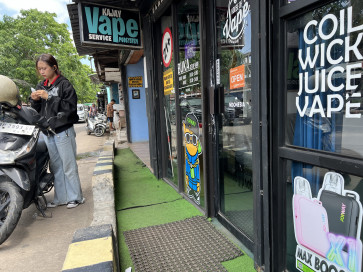Popular Reads
Top Results
Can't find what you're looking for?
View all search resultsPopular Reads
Top Results
Can't find what you're looking for?
View all search resultsGovernment to tighten regulations following AirAsia accident
In this Sunday, Jan
Change text size
Gift Premium Articles
to Anyone
 In this Sunday, Jan.11, 2015 file photo, crew members of Crest Onyx recovery ship prepare to unload the newly-recovered tail section of crashed AirAsia Flight 8501 at Kumai port in Pangkalan Bun, Central Borneo, Indonesia. Indonesian investigators say a faulty rudder control system and the pilots' response led to the crash of the plane last year that killed all 162 people on board. The National Transportation Safety Committee announced Tuesday, Dec. 1, 2015, that an analysis of Flight 8501's data recorder showed that the Airbus A320 had problems with its rudder control system while flying between the Indonesian city of Surabaya and Singapore on Dec. 28. (AP/Achmad Ibrahim, File) (AP/Achmad Ibrahim, File)
In this Sunday, Jan.11, 2015 file photo, crew members of Crest Onyx recovery ship prepare to unload the newly-recovered tail section of crashed AirAsia Flight 8501 at Kumai port in Pangkalan Bun, Central Borneo, Indonesia. Indonesian investigators say a faulty rudder control system and the pilots' response led to the crash of the plane last year that killed all 162 people on board. The National Transportation Safety Committee announced Tuesday, Dec. 1, 2015, that an analysis of Flight 8501's data recorder showed that the Airbus A320 had problems with its rudder control system while flying between the Indonesian city of Surabaya and Singapore on Dec. 28. (AP/Achmad Ibrahim, File) (AP/Achmad Ibrahim, File)
I
span class="caption">In this Sunday, Jan.11, 2015 file photo, crew members of Crest Onyx recovery ship prepare to unload the newly-recovered tail section of crashed AirAsia Flight 8501 at Kumai port in Pangkalan Bun, Central Borneo, Indonesia. Indonesian investigators say a faulty rudder control system and the pilots' response led to the crash of the plane last year that killed all 162 people on board. The National Transportation Safety Committee announced Tuesday, Dec. 1, 2015, that an analysis of Flight 8501's data recorder showed that the Airbus A320 had problems with its rudder control system while flying between the Indonesian city of Surabaya and Singapore on Dec. 28. (AP/Achmad Ibrahim, File)
As a result of a crash that killed 162 people, a Transportation Ministry official said on Thursday that the government will tighten regulations on aircraft maintenance and flight crew competence.
The ministry's air transportation director general, Suprasetyo, announced a series of actions to be carried out on the recommendation of the National Safety Transportation Board (KNKT) following Tuesday's release of the results of an investigation into the December 2014 crash of AirAsia flight QZ 8501.
'We have formed a special team to ensure that every safety action recommended by the KNKT will be completed. We are taking a series of corrective actions as a preventive measure so that the same accident will not happen again in the future,' Suprasetyo says.
Aircraft inspectors from the ministry began today to examine all 75 Airbus A320 planes registered in Indonesia, added Suprasetyo.
He said the ministry has assigned a group of specialized engineers to meticulously inspect each airplane in an operation that will continue until June 2016.
Suprasetyo added that there are currently four carriers with registered Airbus A320s: Indonesia AirAsia, Indonesia AirAsia Extra, Citilink and Batik Air.
The ministry's airworthiness and operations director, Muhammad Alwi, said that it will also be mandatory for flight crew to practice flight simulations for the upset recovery of an aircraft every six months, an increase from the previously recommended 12-month timeframe.
AirAsia flight QZ 8501 was en route to Singapore from Surabaya's Juanda International Airport on Dec. 28, 2014 when it experienced a series of interferences to the rudder system during flight. The same problem had been recorded 23 times in the previous 12 months.
The KNKT investigation revealed that the problem occurred four times during the flight, but the flight crew did not respond according to standard procedures. The flight data recorder suggested that the circuit breakers were reset.
Both the auto-pilot and auto-thrust were deactivated shortly afterward, leaving the crew to fly the plane manually using an unfamiliar fly-by-wire system.
The plane went into a steep upward bank when the pilots tried to fly higher and they lost control.
KNKT investigators said the aircraft stalled and subsequently fell and crashed into the Java Sea.
Alwi said that in accordance with the maintenance manual an aircraft can still fly within 10 days of a report being filed about a damaged rudder system before it is grounded and not permitted to fly. This timeframe is set because each aircraft contains two rudder-control units, so if one was damaged, the other could still function, says Alwi.
He added that according to the records, each reported damage to the aircraft was immediately dealt with and therefore the plane was allowed to fly.
The KNKT investigation concluded that rudder failure and flight crew response lead to the downing of flight QZ 8501.
Suprasetyo also confirmed that the Transportation Ministry was continuing the suspension of Indonesia AirAsia's Surabaya-Singapore route, which was imposed after the crash, and would only consider lifting it when the carrier complies with the recommendations made by the KNKT. (dan)(+)









